
|
Here are some interesting projects you might enjoy trying as you work through MathLinks 7 Adapted. Do them alone or in a group.
To view these files, Adobe's free Acrobat Reader application is required.
|
|
Tips for Students Why Studying Math is Different · Reading math is not like reading a novel. You may have to stop and think about some lines before continuing. · It is important that you understand each concept you learn in math. If you miss a concept one day, you might not be able to understand concepts you study later. Get help if you do not understand something. · Make friends with people who can help you if you are having trouble understanding something. Get help on the telephone or by email or instant messaging. · Participate when you are in class. Answer questions and volunteer to write your answers on the blackboard. Ask questions if you are confused. · Math is learned by doing problems. You get really good at math by doing problems yourself. You might need to ask for help, but do as much as you can on your own. · Problem-solving is an important skill. There are tips for problem-solving on page xii of MathLinks 7 Adapted. The steps are: · Before you begin an assignment, look at your class notes. Make sure you understand the examples and any new words. · Use the Foldable at the beginning of each chapter to keep track of information. · If you have finished the assigned problems and still don’t feel comfortable with the concepts, do more questions. The MathLinks 7 Adapted student site has many things to help you. Go to www.mathlinks7.ca and follow the links to the student site to find more resources. · If you cannot finish your entire math assignment, it is better to do a few problems from each part than just the first problems in the assignment. · If you do not have very much homework, use the extra time to review and practise concepts you learned earlier in the year. · If you do your homework every day and make sure you understand concepts as you learn them, it is easier to study for tests. All you need to do is review the concepts you will be tested on and do some practice problems. · When you get your test, take a minute to look over it. You do not have to do question #1 first. If you know how to do question #3, do that one first. · Don’t get stumped by a question. If your strategy isn’t working, go to another question. · Sometimes you will not be able to finish a test in the amount of time given. Don’t panic. Do as many questions as you can. · Read each question carefully. Underline what the question is asking for. Make sure you answer what the question is asking. · Show your work. If you make a mistake, you will get some marks. |
| British Columbia Ministry of Education | ||
| The British Columbia Ministry of Education site is an excellent general source for policy initiatives, curriculum, division of responsibilities and services, and other information on the educational system in British Columbia. ( http://www.gov.bc.ca/bvprd/bc/channel.do?action=ministry&channelID=-8382&navId=NAV_ID_pro... ) |
||
| Alberta Ministry of Education | ||
| The Alberta Ministry of Education site is an excellent general source for policy initiatives, curriculum, division of responsibilities and services, and other information on the educational system in Alberta. ( http://ednet.edc.gov.ab.ca/ ) |
||
| Manitoba Ministry of Education | ||
| The Manitoba Ministry of Education site is an excellent general source for policy initiatives, curriculum, division of responsibilities and services, and other information on the educational system in Manitoba. ( http://www.edu.gov.mb.ca/ ) |
||
| Yukon Ministry of Education | ||
| The Yukon Ministry of Education site is an excellent general source for policy initiatives, curriculum, division of responsibilities and services, and other information on the educational system in Yukon. ( http://www.education.gov.yk.ca/ ) |
||
| Northwest Territories Ministry of Education | ||
| The Northwest Territories Ministry of Education site is an excellent general source for policy initiatives, curriculum, division of responsibilities and services, and other information on the educational system in Northwest Territories. ( http://www.gov.nt.ca/agendas/education/index.html ) |
||
| Nunavut Ministry of Education | ||
| The Nunavut Ministry of Education site is an excellent general source for policy initiatives, curriculum, division of responsibilities and services, and other information on the educational system in Nunavut. ( http://www.gov.nu.ca/ ) |
||
| Census at School | ||
| Census at School is an international classroom project for students aged 8 to 18, hosted by Statistics Canada. They complete a brief online survey, analyze their class results, and compare themselves with students in Canada and other countries. There is a wealth of data from a survey of students conducted by Statistics Canada in 2005/2006 about topics that students find interesting. ( http://www19.statcan.ca/ ) |
||
| Math Central | ||
| Math Central is an Internet service for mathematics teachers and students from kindergarten to grade twelve. Included on the site are a Resource Room containing shared resources and teaching ideas, the Teacher Talk Listserv discussion forum, mathematics projects, a question-and-answer forum, a bulletin board, and a monthly mathematics problem. ( http://mathcentral.uregina.ca/ ) |
||
| Mathematics Council of the Alberta Teachers' Association | ||
| The MCATA maintains an excellent site. It is a source of information on conferences and resources for teachers of mathematics. ( http://www.mathteachers.ab.ca/ ) |
||
| Saskatchewan Mathematics Teachers' Society | ||
| The SMTS maintains an excellent site. It is a source of information on conferences and resources for teachers of mathematics. ( http://www.smts.ca/ ) |
||
| Manitoba Association of Mathematics Teachers | ||
| The MAMT maintains an excellent site. It is a source of information on conferences and resources for teachers of mathematics. ( http://www.mamt.mb.ca/ ) |
||
| Mathematics Teacher Sites from other Jurisdictions | ||
| Ontario Association of Mathematics Educators ( http://www.oame.on.ca/main/index1.php ) |
||
| National Council of Teachers of Mathematics | ||
| The NCTM offers a comprehensive site that includes electronic resources, professional development, lesson plans, professional publications, and news from the world of mathematics. ( http://www.nctm.org/ ) |
||
| Learn Alberta Math Glossary | ||
| This site offers a glossary of mathematical terms organized by grade level. Also offered are interactive applets geared to the WNCP mathematics program. ( http://www.ronblond.com/MathGlossary/ ) |
||
| The Math Forum (Drexel University) | ||
| The Math Forum at Drexel University is a comprehensive site for mathematics resources, including discussion groups, problems of the week, mathematics resources from K-12, innovations, and the popular Ask Dr. Math question-and-answer forum. ( http://mathforum.org/ ) |
||
| Mudd Math Fun Facts | ||
| The Mudd Math site contains hundreds of interesting mathematics facts useful for adding interest to assignments or researching the background to a topic. The facts are organized by topic (algebra, geometry, probability, etc). Famous problems (the Birthday problem, colouring pizza slices, Devil's staircase, etc) are listed by name. ( http://www.math.hmc.edu/funfacts/ ) |
||
| Fun Math Lessons by Cynthia Lanius | ||
| Cynthia Lanius of Rice University has created a number of mathematics lessons with an emphasis on having fun. Ms. Lanius also offers professional advice on mathematics instructional methods that appeal to girls and under-represented minorities. ( http://math.rice.edu/~lanius/Lessons/ ) |
||
| Figure This! Math Challenges | ||
| This site contains a large number of fun mathematics challenges. The challenges can be listed by title, or arranged into mathematics topics such as linear equations, transformations, area and circumference, etc. ( http://www.figurethis.org/index.html ) |
||
| Coolmath 4 Teachers | ||
| The Coolmath site includes continuing education for teachers, activities for group learning, resources for teaching algebra, and fun activities for teaching and learning mathematics. Although it is a UK site, the mathematics is international. This is a commercially sponsored site; it includes advertising banners. ( http://www.coolmath.com/teachers/ ) |
||
| Mathematicians and their Biographies | ||
| This site includes biographies, often with pictures or paintings, of famous mathematicians, as well as others. There is a special link for female mathematicians. Also available are timelines, quotations, birthplace maps, and a "mathematicians of the day" feature for any date. ( http://www-gap.dcs.st-and.ac.uk/~history/BiogIndex.html ) |
||
| Geometry From the Land of the Incas | ||
| Geometry from the Land of the Incas contains geometry problems, illustrations, and historical references from Inca culture, including Cuzco, Macchu Picchu, the Nazca Lines, and even an "Incan" city on Mars. Resources include quizzes, crosswords, matching, and puzzles. ( http://agutie.homestead.com/files/index.html ) |
||
| Math Archives | ||
| The Math Archives include a searchable database of teaching materials organized by mathematical topic. The site, which includes mathematics at all levels through university, has a K-12 section. Downloadable mathematics software, both freeware and shareware, is available both on-site and through additional links. ( http://archives.math.utk.edu/ ) |
||
| Math is Fun | ||
| This is a general site for all things mathematical. It includes games, puzzles, quizzes, worksheets, self tests, nets for polyhedra, and many other items. ( http://www.mathisfun.com/ ) |
||
| Math Learning Disabilities | ||
| Many students have difficulty learning mathematics due to various learning disabilities. Some of these are well-known, others are not. At the LD site, parents can find general information on the specific types of learning disabilities that affect the learning of math, and suggestions for overcoming these disabilities. A few of those addressed include arithmetic weakness (grasp of concepts, but inability to calculate answers), mathematical symbology and concrete materials, and visual-spatial cognitive difficulties. ( http://www.ldonline.org/ld_indepth/math_skills/garnett.html ) |
||
| Math Camp | ||
| The Canada/USA Mathcamp is an intensive 5-week summer program for mathematically talented high school students. Activities include exposure to topics not normally covered in the school curriculum, a chance to meet and work with eminent mathematicians, fellowship with other students of similar interests and talents, and exposure to a possible career in mathematics, science, or engineering. ( http://www.mathcamp.org/ ) |
||
| International Mathematics Olympiad | ||
| The International Mathematics Olympiad is held in a different country each year. The last Canadian hosting was in North York in 1995. The Canadian site includes results, sample exam questions for aspiring math Olympians, frequently-asked questions, and links to the sites of other countries. ( http://imo.math.ca/ ) |
||
| Stenhouse Publishers | ||
| Stenhouse Publishers provides professional development books and videos for teachers. Check out the website for interesting tips, videos, and articles! ( http://www.stenhouse.com/html/home.htm ) |
||
| The Fruit Game | ||
| The Fruit Game is an interactive Nim-type game. Several kinds of fruit are placed on the "table". You may go first, or tell the computer to go first. You, or the computer, "eat" as many of one kind of fruit as you like per turn. The object is to beat the computer by removing the last piece of fruit from the table. ( http://www.2020tech.com/fruit/index.html ) |
||
| The Game of Life | ||
| The game of life uses biological growth patterns as well as mathematical patterning to create a simulation of the growth or death of a culture. There are several rules for survival, which you can mix and match. The object is to create a living system that is able to sustain itself. ( http://www.math.com/students/wonders/life/life.html ) |
||
| Hex-7 | ||
| Hex-7 is a strategy game that requires players to build a path across a playing surface made up of hexagons. You play against the computer and have the choice of first or second move. The game is offered at novice and advanced levels. ( http://www.mazeworks.com/hex7/index.htm ) |
||
| Hare and Hounds | ||
| Hare and Hounds is a strategy game popular in 19th century France among military officers. You can select hare or hounds. The hare must elude the hounds and escape. The hounds must trap the hare so that it cannot move. The game is offered at beginner and advanced levels. ( http://www.math.com/students/puzzles/hare/hare.html ) |
||
| Rubik's Cube | ||
| The Rubik's Cube applet allows you to manipulate a Rubik's Cube in three dimensions. The applet will randomly scramble the cube for you. ( http://www.javaonthebrain.com/java/rubik/ ) |
||
| Gomoku | ||
| Gomoku is a version of Tic Tac Toe that is played on an infinite game space and requires the winner to get five spheres in a row. You play against the computer. The game board is resizeable. ( http://www.checkers.ws/board_games/gomoku/gomoku_online.htm ) |
||
| Sudoku | ||
| Sudoku is a classic numbers game that requires you to complete a puzzle based on the integers 1 to 9. Once you have mastered the Easy level, you can proceed through Medium and Hard to Evil levels. ( http://www.websudoku.com/ ) |
||
| angle | The figure formed by two lines with a common endpoint called a vertex. |
||||||
| angle bisector | The line that divides an angle into two equal parts. (See page 95, Chapter 3.) |
||||||
| area | The number of square units contained in a two-dimensional region. |
||||||
| base (2-D geometry) | A side of a two-dimensional closed figure. Common symbol is b. (See page 101, Chapter 3.) |
||||||
| Cartesian plane | The plane formed when a horizontal number line and a vertical number line cross. Also called a coordinate grid.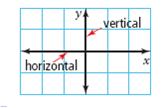 (See page 4, Chapter 1.) |
||||||
| central angle | An angle formed by two radii of a circle. The vertex of the angle is at the centre of the circle.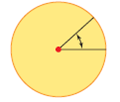 (See page 292, Chapter 8.) |
||||||
| circle | A set of points that are all the same distance from a fixed point called the centre. (See page 266, Chapter 8.) |
||||||
| circle graph | A graph that represents data using sections of a circle. (See page 287, Chapter 8.) |
||||||
| circumference | The distance around a circle. This is a linear measurement. Represented by the variable, C. (See page 274, Chapter 8.) |
||||||
| common denominator | A common multiple of the denominators of a set of fractions.
|
||||||
| common factor | A number that two or more numbers are divisible by.
4 is a common factor of 8 and 12. (See page 203, Chapter 6.) |
||||||
| constant | A number that does not change. Increases or decreases the value of the expression no matter what the value of the variable.
In 2x + 4, the number 4 is the constant. (See page 360, Chapter 10.) |
||||||
| coordinates | The values in an ordered pair (x, y). (See page 5, Chapter 1.) |
||||||
| denominator | The number of equal parts in the whole or the group.
|
||||||
| diameter | The distance across a circle through its centre. Represented by the variable, d.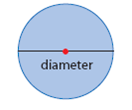 (See page 269, Chapter 8.) |
||||||
| divisible | When a number can be divided by another number evenly, with no remainder. (See page 199, Chapter 6.) |
||||||
| equally likely | Each outcome has the same chance of occurring. |
||||||
| equation | A mathematical statement with two expressions that have the same value.
3a – 21 = 4 and 2a = 6 – b are equations. (See page 391, Chapter 11.) |
||||||
| equivalent fractions | Fractions that represent the same part of a whole or group.
|
||||||
| estimate | To approximate an answer. (See page 45, Chapter 2.) |
||||||
| experimental probability | The probability of an event occurring based on experimental results. (See page 184, Chapter 5.) |
||||||
| exponent | The number of factors you multiply.
In the term 52, the number 2 is called an exponent. |
||||||
| expression | Any single number or variable, or a combination of operations involving numbers and variables.
2y - 7, 11x, and 14 are expressions. (See page 358, Chapter 10.) |
||||||
| factors | Numbers that are multiplied to produce a product. |
||||||
| favourable outcome | A successful result in a probability experiment. (See page 160, Chapter 5.) |
||||||
| fraction | A number that represents a part of a whole or a part of a group. |
||||||
| frequency table | A table used to show the number of occurrences in an experiment or survey. |
||||||
| graph | A visual way to show the relationship between two sets of numbers. (See page 374, Chapter 10.) |
||||||
| height | The perpendicular distance from the base to the opposite side. Common symbol is h.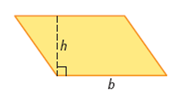 (See page 101, Chapter 3.) |
||||||
| improper fraction |
|
||||||
| independent events | A result in which the outcome of one event has no effect on the outcome of another event. (See page 166, Chapter 5.) |
||||||
| integer | Any of the numbers …, -3, -2, -1, 0, +1, +2, +3, …. |
||||||
| line | A set of points that contains no endpoints. |
||||||
| line segment | The part of a line between two endpoints. |
||||||
| linear relation | A pattern made by two sets of numbers that results in points along a straight line when graphed on a coordinate grid.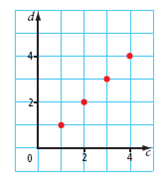 (See page 372, Chapter 10.) |
||||||
| lowest terms | When the numerator and denominator of a fraction have no common factors other than 1. (See page 204, Chapter 6.) |
||||||
| mean | The sum of a set of values divided by the number of values in the set.
|
||||||
| measure of central tendency | A value that represents the centre of a set of data. It can be the mean, median, or mode. (See page 423, Chapter 12.) |
||||||
| median | The middle number in a set of data after the data have been arranged in order. For the data 2, 5, 6, 8, and 9, the median is 6. For the data 1, 3, 7, 7, 9, and 10, the median is 7. (See page 423, Chapter 12.) |
||||||
| mixed number |
|
||||||
| mode | The most frequently occurring number in a set of data. There can be more than one mode. For the data 3, 5, 7, 7, and 9, the mode is 7. For the data 2, 2, 4, 6, 6, 8, and 11, the modes are 2 and 6. (See page 423, Chapter 12.) |
||||||
| multiple | The product of a given number and a natural number like 1, 2, 3, and so on. Some multiples of 3 are 3, 6, 9, 12, and 15. (See page 232, Chapter 7.) |
||||||
| natural number | Any of the numbers 1, 2, 3, … |
||||||
| numerical coefficient | A number that multiplies the variable.
In 2x + 4, the number 2 is the numerical coefficient. (See page 360, Chapter 10.) |
||||||
| numerator | The number of equal parts being considered in the whole or the group.
|
||||||
| opposite integers | Two integers with the same numeral, but different signs. Two integers represented by points that are the same distance in opposite directions from zero on a number line.
+2 and -2 are opposite integers.   (See page 311, Chapter 9.) |
||||||
| opposite operations | Operations that "undo" other operations. Some people call them "inverse operations." Addition and subtraction are opposite operations. Multiplication and division are opposite operations. (See page 397, Chapter 11.) |
||||||
| order of operations | Correct sequence of steps for a calculation. Brackets first, then multiply and divide in order from left to right, and then add and subtract in order from left to right. (See page 68, Chapter 2.) |
||||||
| ordered pair | A pair of numbers used to locate a point on a coordinate grid.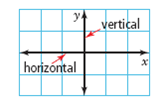 |
||||||
| origin | The point where the x-axis and the y-axis cross. (See page 5, Chapter 1.) |
||||||
| outcome | One possible result of a probability experiment. (See page 160, Chapter 5.) |
||||||
| outlier | A value that is much smaller or larger than the other data values. (See page 435, Chapter 12.) |
||||||
| overestimate | An estimate that is larger than the actual answer. (See page 45, Chapter 2.) |
||||||
| parallel | Describes lines in the same plane that never cross or intersect. (See page 83, Chapter 3.) |
||||||
| parallelogram | A four-sided figure with opposite sides parallel and equal in length. (See page 100, Chapter 3.) |
||||||
| pattern | An arrangement of shapes, colours, numbers, letters, words, and so on, for which you can predict what comes next. (See page 350, Chapter 10.) |
||||||
| percent | Means "out of 100" or "hundredths."
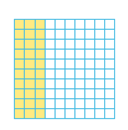 (See page 124, Chapter 4.) |
||||||
| perimeter | The distance around the outside of a two-dimensional shape or figure. |
||||||
| perpendicular | Describes lines that intersect at right angles (900). (See page 83, Chapter 3.) |
||||||
| perpendicular bisector | A line that divides a line segment in half and is at right angles to it.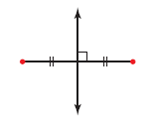 (See page 90, Chapter 3.) |
||||||
| pi | The ratio of the circumference of a circle to its diameter. The symbol for pi is ??. (See page 274, Chapter 8.) |
||||||
| probability | The likelihood or chance of an event occurring. Probability can be expressed as a ratio, fraction, or percent. (See page 158, Chapter 5.) |
||||||
| proper fraction |
|
||||||
| quadrants | The four regions on the coordinate grid. (See page 5, Chapter 1.) |
||||||
| radius | The distance from the centre of a circle to the outside edge. Represented by the variable, r.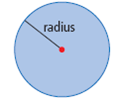 (See page 268, Chapter 8.) |
||||||
| random | An event in which every outcome has an equal chance of occurring. (See page 171, Chapter 5.) |
||||||
| range | The difference between the largest and smallest values in a data set. (See page 435, Chapter 12.) |
||||||
| reflection | A flip over a mirror line.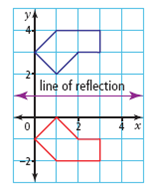 (See page 19, Chapter 1.) |
||||||
| relationship | A pattern formed by 2 sets of numbers. (See page 375, Chapter 10.) |
||||||
| repeating decimal | A decimal number with a digit or group of digits that repeats forever. Repeating digits are shown with a bar.
|
||||||
| rotation | A turn about a fixed point called the centre of rotation.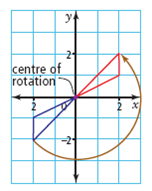 (See page 19, Chapter 1.) |
||||||
| sample space | All possible outcomes of an experiment. (See page 166, Chapter 5.) |
||||||
| sector | The section of a circle formed by two radii and an arc of the circle connecting the radii. (See page 287, Chapter 8.) |
||||||
| semi-circle | Half of a circle. |
||||||
| table of values | A table showing two sets of related numbers. (See page 367, Chapter 10.) |
||||||
| tally chart | A table used to record experimental results or data. Tally marks are used to count the data. |
||||||
| terminating decimal | A decimal number in which the digits stop. 0.4, 0.86, and 0.25 are terminating decimals. (See page 136, Chapter 4.) |
||||||
| theoretical probability | The expected probability of an event occurring. (See page 184, Chapter 5.) |
||||||
| transformation | Moves one geometric figure onto another. Examples are translations, reflections, and rotations. (See page 18, Chapter 1.) |
||||||
| translation | A slide along a straight line. (See page 18, Chapter 1.) |
||||||
| tree diagram | A diagram with a branch for each possible outcome of an event. (See page 167, Chapter 5.) |
||||||
| underestimate | An estimate that is smaller than the actual answer. (See page 45, Chapter 2.) |
||||||
| unit fraction | A fraction with a number of 1.
|
||||||
| value | A known or calculated amount. (See page 360, Chapter 10.) |
||||||
| variable | A letter that represents an unknown number. In 2x + 4, the letter x is the variable. (See page 358, Chapter 10.) |
||||||
| vertex | A point where two sides of a figure meet. Plural is vertices. (See page 13, Chapter 1.) |
||||||
| whole number | Any of the numbers 0, 1, 2, 3, … |
||||||
| x-axis | The horizontal number line on the coordinate grid. (See page 5, Chapter 1.) |
||||||
| x-coordinate | The first number in the ordered pair describing a point on a coordinate grid. The x-coordinate of point P(2, 5) is 2. |
||||||
| y-axis | The vertical number line on the coordinate grid. (See page 5, Chapter 1.) |
||||||
| y-coordinate | The second number in the ordered pair describing a point on a coordinate grid. The y-coordinate of point P(2, 5) is 5. |
||||||
| zero pair | A pair of integer chips, with one chip representing +1 and one chip representing -1. The pair represents zero because (+1) + (-1) = 0. (See page 310, Chapter 9.) |
||||||
|
Three in a Row (2–4 Players) 1. Print BLM: Three in Row.
2. Use all aces through 9s in a standard deck of cards. The aces count as 1s. Red cards are negative, and black cards are positive.
3. Deal eight cards to each player. Place the remainder face down to be used as a draw pile.
4. The first player selects two cards from his or her hand to represent the coordinates of a point on the Cartesian grid.
• This point is marked on the grid using an initial or other symbol to identify the player. • The two cards are placed in a discard pile, and the player draws two new cards. 5. Play moves clockwise. The next player takes a turn by playing a card and placing that number on the coordinate grid, then picking up a replacement card from the draw pile.
6. The first player to plot three points along the same line is the winner.
7. When all of the cards in the draw pile have been drawn, shuffle the discard pile and use it as the draw pile.
Notes:
a) Once a grid point is selected, no other player may select the same point. b) It is not legal to place a point on one of the axes. |
| Want a fun way to test your knowledge of math terms? Try this Crossword Puzzle and see how many you can get! |
|
Want a fun way to test your knowledge of math terms? Try this Crossword Puzzle and see how many you can get!
|
|
Hit the Target (2 Players) Materials Needed: 1. Print and cut out the four cards on BLM: Hit the Target.
2. Remove the queens, kings, and jokers from a pack of playing cards.
• Aces represent 1s, and jacks represent 0s.
• Other cards represent their face numbers. Use two coins per player as decimal points.
3. One player starts by dealing four playing cards to each player, and turning over one of the target cards.
4. Players use their four numbered cards and the two coins to form two decimal numbers.
• The objective is to form two numbers with a product closest to the target card.
• The player closest to the target card wins all 8 cards.
• In case of a tie, players retrieve their own cards.
5. Play moves clockwise. For the second round, each player is dealt 4 new numbered cards and a new target card is turned over.
6. When all four target cards have been played, the game ends.
7. The player with the most playing cards at the end of the game is the winner.
|
|
Spin and Draw (Any Number of Players) Materials Needed: 1. Print the spinners on BLM: Spin and Draw. Use the paper clips and pencils to complete the spinners.
2. The first player spins the shape spinner and the spinner with numbers, which is the area spinner.
• This player then sketches that shape, showing a base and height that produce the required area. • The second player times how long this takes. 3. If the other players agree that the shape and dimensions are correct, the player scores 100 points minus the number of seconds it took to finish the drawing.
4. Play moves clockwise. The player who just played is the timer for the next player.
5. If the same shape and area are spun during the same round, the player may not use the same dimensions that have already been used.
6. Continue until all players have had a turn.
7. In the second round, the numbers 1 and 2 may not be used as dimensions. Players who spin these areas must spin the area spinner again.
8. The first player to reach 500 points wins.
|
| Want a fun way to test your knowledge of math terms? Try this Crossword Puzzle and see how many you can get! |
|
Match and Win (2–4 Players) Materials Needed: • scissors
• 1. Print and cut out the 60 cards on BLM: Match and Win.
2. Shuffle and deal eight cards to each player. Place the remaining cards face down on the table.
3. Select a player to begin. The player may lay down any two cards that are equivalent.
Example: 0.5 is equivalent to ½ or 50%. • If the rest of the players agree that the cards are equivalent, they are put aside, and the player scores 5 points. • The player then draws one card from the pile, and must discard one. • If a further match occurs, it may be put down and scored. 4. The next player continues in the same way, putting down any matches to score points. Players may pick up either the top card on the discard pile or from the face-down pile.
5. Play continues until one player runs out of cards. This player scores 5 bonus points. Players with cards still in their hands lose 2 points per card. No one may obtain a score of less than zero after any round.
6. Play continues until players reach a pre-determined score or until the end of a pre-determined time.
|
| Want a fun way to test your knowledge of math terms? Try this Crossword Puzzle and see how many you can get! |
|
Roll and Collect (Any Number of Players) Materials Needed: • 11 counters per player (coins will work fine)
• 2 standard six-sided dice • scissors • 1. Print and cut out one counter board for each player from BLM: Roll and Collect.
2. Players arrange their 11 counters on their playing board any way they like. No more than 3 counters may be placed on any number.
3. The first player rolls a pair of dice, and removes any counters that have been placed on the sum rolled.
4. The next player takes a turn.
5. The player who first removes all counters from their playing board is the winner.
|
| Want a fun way to test your knowledge of math terms? Try this Crossword Puzzle and see how many you can get! |
|
Wholes Only (2–4 Players) Materials Needed: • scissors
• 1. Print and cut out the fraction cards on BLM: Wholes Only. 2. Shuffle, and deal five fraction cards to each player. Place the rest face down in a pile. 3. Players inspect and arrange their cards. • The object is to find groups of fractions that add to a whole number. • The Wild Card may take on any fractional value between 0 and 1. 4. The first player places any group of cards that add to a whole number on the table, then draws a card. The next player does the same. 5. Play continues clockwise until all of the cards have been drawn, or one player lays down the last card from his/her hand. 6. Players score 20 points, minus the number of cards remaining in their hand. 7. Shuffle the cards and deal again. Play may continue for as many rounds as the players wish. |
| Want a fun way to test your knowledge of math terms? Try this Crossword Puzzle and see how many you can get! |
|
Sevens Down (2–4 Players) Materials Needed: • scissors
• 1. Print and cut out the fraction cards on BLM: Sevens Down. 2. Shuffle, and deal the fraction cards evenly to all players. If any are left over, put them aside. 3. Players select a card and place it face up on the table. • The player whose fraction has the greatest value collects all of the cards played and sets them aside. • The Wild Card beats all other cards. 4. Play continues until all cards have been played. 5. Players total the value of the fractions on all cards that they have won, except the cards containing a seven in the numerator or denominator. These cards have a value of 0. The greatest total wins. |
| Want a fun way to test your knowledge of math terms? Try this Crossword Puzzle and see how many you can get! |
|
Circular Ashte Kashte (2–4 Players) Materials Needed: • 4 tokens per player (each player should have distinguishable tokens) • 4 coins per group • Ashte Kashte is a racing game thought to have originated in India. A variant of the standard board is the circular board, consisting of a number of concentric circles. From 2 to 4 players begin on the coloured sectors. The object of the game is to reach the circle in the centre before anyone else.
1. Use the game board on BLM: Circular Ashte Kashte.
2. Players start on their starting sector. One at a time, they toss the four coins and move a token counterclockwise around the ring the number of spaces equal to the number of heads showing from their toss. 3. Play moves clockwise. • On a second or subsequent turn, players may choose to start another token, or continue with the first token. • Tokens move around the board until they have covered the first circle. • They then move inwards to the next circle closer to the centre, and proceed counterclockwise. 4. Players who land a token on a sector occupied by an opponent’s piece capture the piece. The piece is removed from the board and has to start again. • Pieces on a coloured sector cannot be landed on or captured. 5. Players who land on one of their own pieces create a double piece. • Doubles may be moved together. • Only other doubles can capture them. • Doubles cannot be passed over, or jumped. 6. The middle circle may be entered only by a direct throw. If a player throws too high a number, another token must be moved, or the turn is forfeit. 7. The winner is the first player with all four tokens in the centre. |
| Want a fun way to test your knowledge of math terms? Try this Crossword Puzzle and see how many you can get! |
|
Want a fun way to test your knowledge of math terms? Try this Crossword Puzzle and see how many you can get!
|
|
Integer Race (Any Number of Players) Materials Needed: • 2 paperclips • 2 pencils • 1 counter per player • 1. Print the spinners and game board on BLM: Integer Race. Use paper clips and pencils to complete the spinners. 2. Each player selects a counter and places it on Start. 3. Players spin the Integer spinner, and then the Sign spinner. • The value of the Integer spinner indicates how many spaces may be moved. • The Sign spinner indicates the direction of movement. Move clockwise for + and counterclockwise for –. Your Choice allows the player to select the direction. 4. Players who land on a space marked Lose a Turn, lose their next turn. • Players who land on a space marked Your Choice, may choose the direction of their next move without using the Sign spinner. • Players who land on a space marked Double Spin may have an extra turn. 5. The first player to complete one lap in either direction wins. |
|
Want a fun way to test your knowledge of math terms? Try this Crossword Puzzle and see how many you can get!
|
|
Deduce the Digits (2 Players) Materials Needed: • pencil • paper 1. Player 1 writes a 2-digit number on a piece of paper and turns it over so that Player 2 cannot see it. 2. Player 2 guesses a 2-digit number. • If neither of the digits in Player 2’s number matches any digit in the hidden number, Player 1 must say “Miss.” • If one of the digits guessed matches one of the digits in the hidden number, and it is in the correct decimal place, Player 1 must say “Hit.” • If one of the digits guessed matches one of the digits in the hidden number, but it is in the wrong decimal place, Player 1 must say “Wing.” 3. Player 2 uses the results of the first guess to make a second guess. Play continues until Player 2 either guesses the number, or has made 8 unsuccessful guesses. 4. Players switch roles, and play again. 5. Points are awarded according to the table. The winner is the first player to reach or exceed 25 points. Example: Hidden number: 39 Player’s guess: 23 The digit 3 matches one of those in the hidden number, but is in the wrong decimal place. Award 1 wing. Player takes 5 guesses to get the correct answer. Number of points earned: 6 |
|
Want a fun way to test your knowledge of math terms? Try this Crossword Puzzle and see how many you can get!
|
|
Cups and Counters (Any Number of Players) Materials Needed: • 6 plastic cups • 24 plastic counters • timer • 2 standard six-sided dice 1. One at a time, players roll a die, and receive a number of plastic cups equal to the number rolled. • They then roll two dice, add their values, add 12, and receive that number of counters. • Players must model an equation by placing the same number of counters in each cup (at least one per cup) but allowing some counters outside the cup. The left side of the equation must equal the right side of the equation. • Players have one minute to complete their equation. • They earn 10 points for an equation that works. 2. Play moves clockwise until each player has had one turn. 3. On the second round, the time is reduced by 10 s. It is reduced by another 10 s on each of the following rounds. 4. The winner is the player with the most points after four rounds. Example: Each cup contains 3 counters. The equation in the diagram works. It represents: 2x + 4 = 10 |
|
Want a fun way to test your knowledge of math terms? Try this Crossword Puzzle and see how many you can get!
|
| Stenhouse Publishers | ||
| Stenhouse Publishers provides professional development books and videos for teachers. Check out the website for interesting tips, videos, and articles! ( http://www.stenhouse.com/html/home.htm ) |
||
|
Triple M Challenge (2–4 Players) Materials Needed: • deck of standard playing cards 1. Remove the jacks, queens, kings, and jokers from the deck of cards. 2. Each player is dealt 10 cards. 3. Players may elect to play the mean, the median, or the mode of the 10 cards in their hand. One minute is allowed for calculations. 4. The player with the highest number wins, and is awarded 12 points. If more than one player has the same highest number, the points are split among the tied players. 5. Shuffle the cards and deal again. 6. The first player to reach or exceed 50 points wins. |